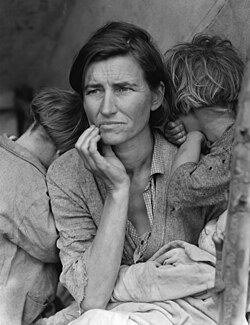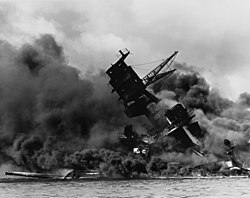1930s
Presidency of Herbert C. Hoover

- 1930 – The Great Depression in the United States continues to worsen, reaching a nadir in early 1933.
- 1930 – The Motion Picture Production Code becomes set of industry censorship guidelines governing production of the vast majority of United States motion pictures released by major studios; is effective for 38 years
- 1930 – Frozen vegetables, packaged by Clarence Birdseye, become the first frozen food to go on sale
- 1930 – The Democrats take Congress in the Midterms. Will keep it until 1946.
- 1930 - Hawley-Smoot Tariff
- 1930 - Clyde Tombaugh discovers Pluto
- 1930 - Sinclair Lewis is the first American to win Nobel Prize for Literature
- 1931 – Empire State Building opens in New York.
- 1931 – Japanese invasion of Manchuria, start of World War II in the Pacific.
- 1931 – The Whitney Museum of American Art opens to the public in New York City.
- 1931 - “The Star-Spangled Banner” becomes official U.S. national anthem
- 1931 - Hoover vetoes Veteran Bonus
- 1931 - Pearl Buck publishes The Good Earth making heroes of the Chinese peasants
- 1932 – Stimson Doctrine opposes Japanese expansion into Manchuria
- 1932 – Norris-La Guardia Act strengthens labor unions
- 1932 - Baby son of Charles Lindbergh was kidnapped and found dead
- 1932 – Bonus Army marches on DC; repressed by President Hoover
- 1932 – Reconstruction Finance Corporation finances relief
- 1932 – U.S. presidential election, 1932: Franklin D. Roosevelt elected president, John N. Garner elected vice president
- 1933 – Chicago Mayor Anton Cermak killed during a failed assassination attempt on President-elect Roosevelt by Giuseppe Zangara; the intended target was not wounded.
- 1933 - Over 12 million or 25% of Americans were unemployed
- 1933 – 20th Amendment, establishing the beginning and ending of the terms of the elected federal offices.
Presidency of Franklin D. Roosevelt
- March 4, 1933 – Roosevelt becomes the 32nd president. He is the last president to be inaugurated on March 4. It also began his "Hundred Days". Garner becomes the 32nd vice president. He is the last vice president to be inaugurated on March 4.
- 1933 – President Roosevelt establishes the New Deal, a response to the Great Depression, and focusing on what historians call the "3 Rs": relief, recovery and reform
- 1933 - Emergency Banking Act
- 1933 – Sweeping new programs proposed under President Roosevelt take effect: the Agricultural Adjustment Act, Civil Works Administration, Civilian Conservation Corps, Farm Credit Administration the Home Owners' Loan Corporation, the Tennessee Valley Authority, the Public Works Administration, the National Industrial Recovery Act
- 1933 - San Francisco Ballet founded
- 1933 – Frances Perkins appointed United States Secretary of Labor
- 1933 – 21st Amendment, ending Prohibition
- 1933 - United States government recognizes the Soviet Union
- 1934 – Glass–Steagall Act
- 1934 – U.S. Securities and Exchange Commission established
- 1934 – Dust Bowl begins, causing major ecological and agricultural damage to the Great Plains states; severe drought, heat waves and other factors were contributors.
- 1934 – Federal Housing Administration
- 1934 – Johnson Act
- 1934 - Indian Reorganization Act
- 1934 – Philippine Commonwealth established
- 1934 – Reciprocal Trade Agreements Act
- 1934 – Tydings–McDuffie Act
- 1934 – John Dillinger killed
- 1934 – Indian Reorganization Act
- 1934 – Share the Wealth society founded by Huey Long
- 1934 - The first federal prisoners arrived at Alcatraz
- 1935 – Works Progress Administration
- 1935 – The F.B.I. is established with J. Edgar Hoover as its first director.
- 1935 – Neutrality Act
- 1935 – Motor Carrier Act
- 1935 – Social Security Act
- 1935 – Schechter Poultry Corp. v. United States
- 1935 – National Labor Relations Act
- 1935 – Huey Long assassinated
- 1935 – Congress of Industrial Organizations formed
- 1935 – Alcoholics Anonymous founded
- 1935 – Revenue Act of 1935
- 1935 - Middletown is published
- 1936 – Robinson-Patman Act
- 1936 - Hoover Dam
- 1936 – Life magazine publishes first issue
- 1936 – United States v. Butler , which ruled that the processing taxes instituted under the 1933 Agricultural Adjustment Act were unconstitutional
- 1936 – Second London Naval Treaty
- 1936 - Jesse Owens won 4 gold medals at the Olympics in Berlin, Germany
- 1936 – U.S. presidential election, 1936: Franklin D. Roosevelt reelected president, John N. Garner reelected vice president
- 1936 - 1936 Tupelo–Gainesville tornado outbreak
- 1936 - Babe Ruth and Ty Cobb named to baseball's Hall of Fame
- 1937 – Look magazine publishes first issue
- 1937 – Neutrality Acts
- January 20, 1937 – President Roosevelt and Vice President Garner begin second terms.
- 1937 – Hindenburg disaster, killing 35 people and marking an end to airship travel
- 1937 – Panay incident, a Japanese attack on the United States Navy gunboat USS Panay while anchored in the Yangtze River outside of Nanjing
- 1937 – Golden Gate Bridge completed in San Francisco
- 1938 – Wheeler-Lea Act
- 1938 – Fair Labor Standards Act
- 1938 - Thornton Wilder’s play Our Town wins Pulitzer Prize
- 1938 - The comic book superhero Superman debuts in Action Comics #1 (June 1938)
- 1938 – Orson Welles' The War of the Worlds broadcast
- 1939 – Hatch Act, aimed at corrupt political practices and prevented federal civil servants from campaigning
- 1939 – Nazi Germany invades Poland; World War II begins
- 1939 – Cash and carry proposed to replace the Neutrality Acts
- 1939 – President Roosevelt, appearing at the opening of the 1939 New York World's Fair, becomes the first president to give a speech that is broadcast on television. Semi-regular broadcasts air during the next two years
